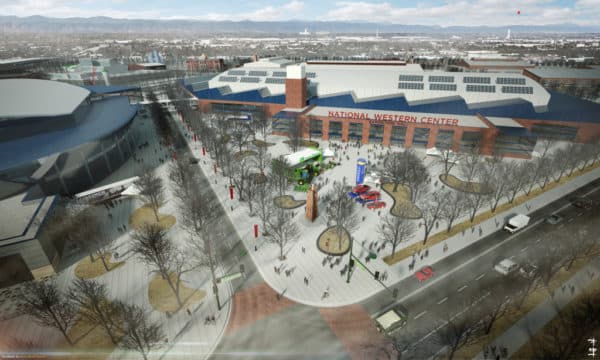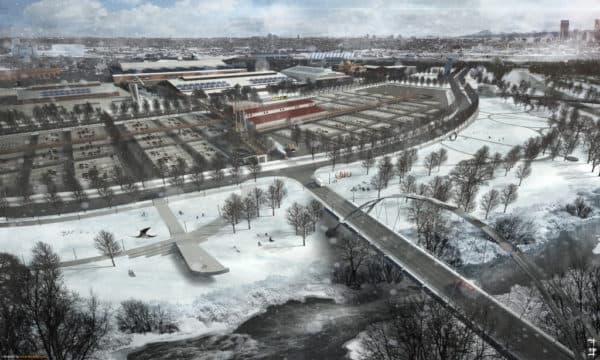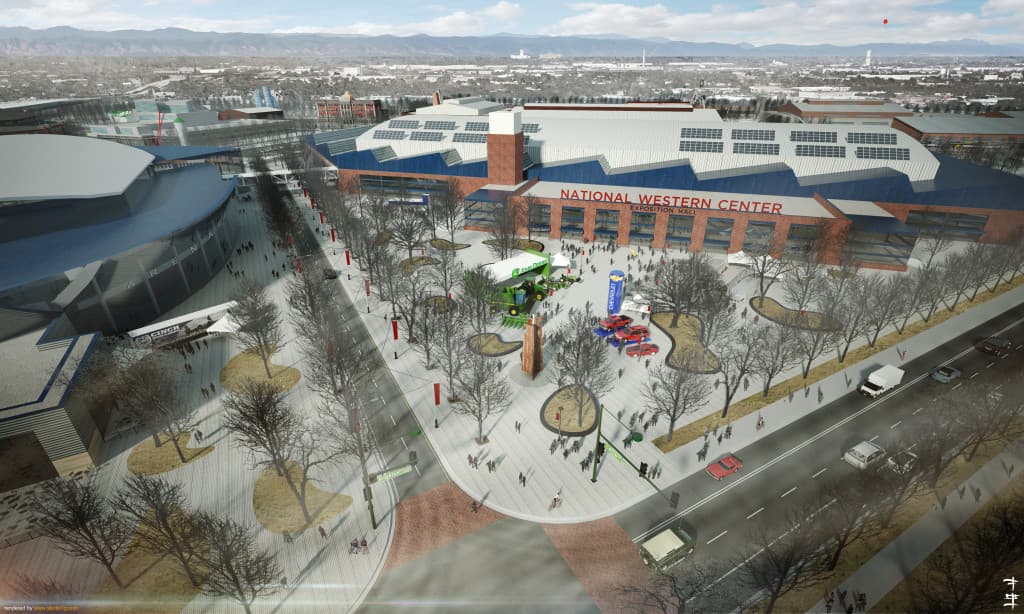
The National Western Stock Show brings more than 600,000 people, 15,000 animals and an estimated $31 million in off-site visitor spending in the city of Denver each year. And back in 2011, organizers were thinking of decamping for Aurora. To stop that from happening, Denver proposed an enormous undertaking that could remake that part of the city.
The National Western Center Master Plan began in an effort to keep the 110-year-old stock show in the city for another 100 years (though there are no written commitments to that effect). The plan envisions a National Western Center that would get year-round use by visitors and residents of nearby neighborhoods while keeping its focus on ranching and agriculture.
"We think this can be a really unique place where people can come any time of year and have something really great to do, whether it is strolling through the campus, attending a paid event, learning about water quality," says Erika Reyes Martinez, a spokeswoman for the North Denver Cornerstone Collaborative. "This place will be a destination for competition, for commerce, for education.
"We need to make sure that whatever we do, we honor the history of the stock show," she adds.
The new National Western will be a lot bigger. Denver is buying up land, roughly 100 acres, to the east of the existing 95-acre complex along Brighton Boulevard and to the north along Race Court. This includes small homes and businesses, large industrial properties and a bus lot owned by Denver Public Schools. The city has set aside $55 million for acquisition and relocation expenses and hopes to have "site control" by the middle of 2017. The additional land will allow for new buildings, more open space, more parking and more roads and paths through the campus.
Some long-time community members told me they would have been fine with the stock show taking its traffic and its smells to Aurora. They see mostly impact and not much benefit to the surrounding neighborhoods from the stock show. City officials say the new campus will provide jobs and educational opportunities and make it easier to get around and across the river, along with hosting all sorts of events.
It'll cost a lot of money. We know where some of it will come from.
The creation of the new National Western will take at least 10 years and cost an estimated $1.1 billion. Denver has promised to spend nearly $669 million, with most of that money coming from extensions of hotel and car rental taxes that voters approved in November 2015. The tourism taxes will pay for $476 million in bonds for the project. Another $121.5 million comes from the state through the Regional Tourism Act, while Colorado State University will pay $16.2 million toward an equine sports medicine facility. The Western Stock Show Association has promised to raise $50 million.
So that's almost $900 million.
City officials don't know yet where they'll get the rest of the money. Options include federal grants, the sale of naming rights, sale of other city property and a visa program that encourages foreign investment.
The plan is ambitious.
In addition to the stock show itself, the facilities planned for the redeveloped National Western could host concerts, hockey games, festivals, trade shows, conventions and even a Winter Olympics bid.

The plan calls for:
- A 10,000-seat arena that includes restaurant and retail space, outdoor exhibition areas and ice capability for hockey games.
- A 350,000-square-foot trade show exposition hall that could accommodate a speed skating oval
- A livestock center with a 5,000-seat, 135,000-square-foot Livestock Stadium Arena; two livestock auction arenas; a 230,000-square foot Livestock Hall with the flexibility to host a range of events; a stockyard show arena with 1,000 seats; and a 20-acre stockyards/event pavilion that would provide 800 animal pens during the shock show and could be converted into space for concerts and festivals the rest of the year. (How will all the animal waste be handled? The city is still figuring that out.)
- An equestrian center with a 4,500-seat, 109,000-square-foot equestrian events center; a 500-seat, 86,500-square-foot equestrian arena; a new 1,000-stall horse barn; an equine sports medicine facility in partnership with Colorado State University that will also include a small animal clinic serving the community; a CSU Temple Grandin Equine Center for horse-assisted therapy programs; and indoor and outdoor practice areas.
- A water resources center in partnership with Colorado State University to provide education on the South Platte River.
The plan also calls for the eventual redevelopment of the Coliseum on the south side of I-70 and identifies sites for private development around the National Western Center.
The plan moves rail lines and a huge sewage interceptor line that run along the South Platte River and creates open space along the banks. It creates two new bridges over the South Platte at 49th Avenue and 51st Avenue and extends 44th Street through the campus as Bettie Cram Drive, named for a long-time community activist.
Colorado State University is a major partner in the new National Western with the equine center, a new Denver extension campus, a food innovation center and other programs, and the city says the site will provide educational opportunities for community members.
The plan also calls for the preservation of a bunch of historic structures, some of which are currently in private hands, like the 1917 Armour Administration Building, the Armour Water Tower and the Livestock Exchange Building.














